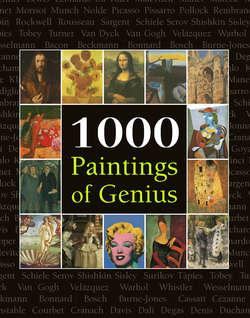1000 Paintings of Genius

Реклама. ООО «ЛитРес», ИНН: 7719571260.
Оглавление
Victoria Charles. 1000 Paintings of Genius
Introduction
13th Century
14th Century
15th Century
16th Century
17th Century
18th Century
19th Century
20th Century
Glossary
A
B
C
D
E
F
G
H
I
M
N
O
P
R
S
T
Chronology
Legends
Отрывок из книги
For the sixteenth-century Italian writer and painter Giorgio Vasari, a dark period in human history ended when God took pity on humankind and brought about a reform of painting. Vasari wrote in his Lives of the Artists of 1550 that the naturalism of Tuscan painters like Giotto di Bondone in the early fourteenth century was a miracle, a gift to humankind to bring about an end to the stiff, formal, unnatural Byzantine style that had held sway before that time. Today, we recognise that it was hardly by chance or divine mercy that such a change occurred in artmaking. The development of crisp, effective narrative, convincing spatial representation, and the introduction of corporeal, realistic figures possessing physical presence are all aspects of painting echoing the changes in European culture that were beginning to take hold by the fourteenth century and later, and which found their most forcible expression in Italy. Set against a social revolution in which traders, manufacturers and bankers were gaining in prominence, painters were responding to the growing demand for clear, naturalistic representation in art. The monumental works of the Florentine Giotto and the elegant, finely wrought naturalism in the paintings of the Sienese Duccio di Buoninsegna were but one part of a larger cultural movement. It also comprised: the moving, vernacular writings of Dante, Petrarch, and Boccaccio; the vivid travel-adventure of Marco Polo; the growing influence of nominalism in philosophy, which encouraged real, tangible and sensate knowledge; and the religious devotion of Saint Francis of Assisi, who found God’s presence not in ideas and verbal speculation but in the chirping of birds and the glow of the sun and moon.
What the primi lumi, the ‘first lights’, in the art of painting had commenced by the fourteenth century was continued in the fifteenth century with ever greater sharpness and thoroughness, and with a new historical sense that caused them to look back before the Middle Ages to the world of the classical civilisations. Italians came to admire, almost worship, the ancient Greeks and Romans, for their wisdom and insight, and for their artistic as well as scholarly achievements. A new kind of intellectual, the humanist, fuelled a cultural revolution in the fifteenth century. A humanist was a scholar of ancient letters, and humanism was the broader attitude they fostered: a belief in the value of a thoughtful study of Nature, a faith in the potentiality of humankind, and a sense that secular, moral beliefs were necessary to supplement the limited tenets of Christianity. Above all, the humanists encouraged the belief that ancient civilisation was the apex of culture and one should be in a dialogue with the writers and artists of the classical world. The result was the Renaissance, the rebirth, of Greco-Roman culture. The panels, paintings and murals of Masaccio and Piero dell Francesca captured the moral firmness of ancient Roman sculptural figures, and these artists strove to show their actors as part of our world: the Renaissance perspective system is based on a single vanishing point and carefully worked out transversal lines, resulting in a spatial coherence not seen since antiquity, if ever. Even more clearly indebted to antiquity were the paintings of the northern Italian prodigy Andrea Mantegna. His archaeological studies of antique costumes, architecture, figural poses, and inscriptions resulted in the most thoroughly consistent attempt by any painter up to his time to give new life to the vanished Greco-Roman civilisation. Even a painter like Alessandro Botticelli, whose art evokes a dreamy spirit that had survived from the late Gothic style, created paintings with Venuses, Cupids, and nymphs that responded to the subject matter of the ancients and appealed to contemporary viewers touched by humanism.
.....
Bellini knows the Florentine pictorial researches (a lot of Florentine artists travelled to Venice at the time) and he introduced oil painting in Venice. Traditionally, the Virgin was holding the dead Christ on her knees. In this painting Bellini proposes a new iconography and a new-size landscape format. In the foreground, a stone pedestal evokes the tomb of Christ. The search for volume and geometry is characteristic of the artist’s work.
102. Piero della Francesca, c. 1416–1492, Early Renaissance, Italian, Resurrection, 1463, Mural in fresco and tempera, 225 × 200 cm, Museo Civico, Sansepolcro
.....